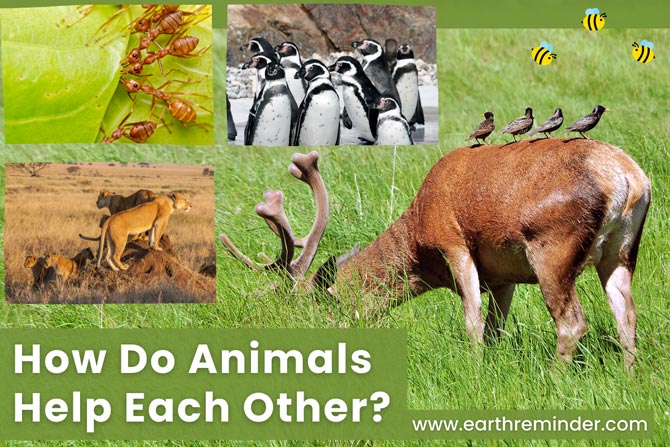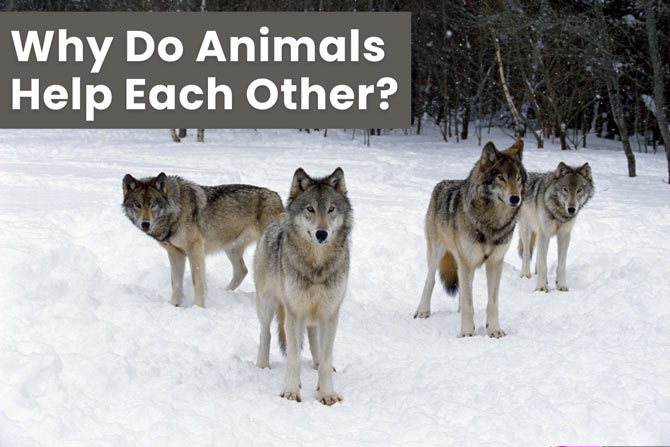How Do Animals Help Each Other?
How Do Animals Help Each Other? – With Examples:
Each of us has witnessed animals helping each other out either in person or on the internet. Watching them support each other usually gives us a warm and devoted feeling. It is claimed that humans have spent a couple of million years protecting and helping one another. However, it is not the only creature that does so. Now, it has become well-known that animals exhibit humanitarian instincts. For instance, taking care of other members of their species for survival, keeping an eye out for predators, and enjoying meals are a few examples of how they support one another. On this note, let’s continue learning as we move forward in this context.
Table of Contents
Animals Helping Each Other: The Science Behind the Altruism
In altruism, one is selfless and concerned about the well-being of others. To put it simply, altruism is the belief that we are all interconnected and that what benefits one person can ultimately benefit us all. Let’s understand this concept from the perspective of how animals help each other.
It has been demonstrated that there are approximately 8.7 million life forms in existence. Despite this ever-growing and diverse range of species, animals have peacefully coexisted in the same region for decades. The science of how the species interact with one another in a particular ecosystem is popularized as symbiosis. So, we can say that although life within the animal kingdom might be challenging, the animals are all capacitated to stick together and work in a system.
Speaking of symbiotic relationships, it covers four significant aspects: communalism, competition, mutualism, and parasitism. As we have already got into this subject, let us know how this symbiosis can prove advantageous for the animals.
Advantages of Symbiosis
To seek a better view of how animals help each other, it is essential first to discuss the four primary roles of the subcategories under symbiosis with examples.
- Mutualism: It is the idea that focuses on how organisms cannot survive without one another. It typically uses other organisms for food, cleaning, or protection. In the mutualistic interaction between cleaner wrasse and reef fish, for instance, reef fish cannot survive without the wrasse’s assistance in eliminating the parasites. And at the same time, the wrasse cannot survive without the reef as it provides a habitat.
- Communalism: It mainly focuses on one-sided symbiosis, which signifies that this relationship will favor only one organism. For example, Remora fish attach themselves to the wild sharks and whales and eat the leftover material of the food eaten by these massive predators. Therefore, the other animal does not usually benefit but does not suffer any injury or damage due to the symbiosis.
- Parasitism: You must be aware of how a tapeworm’s life solely depends on the digested food in the small intestine of several animals. Such organisms are called parasitic organisms, and their relationship with the host is called the parasitic relationship.
- Competition: It is another element of symbiosis that necessitates struggle amongst the organism for food. Such competition is crucial as it helps maintain the ecosystem’s balance. For the species to survive longer and operate when resources are few, predation within the species is essential. One such event involves a lion stalking and killing a deer, drastically reducing the herd.
Henceforth, many ecosystems in nature could decline and stop functioning without symbiosis. All the components of symbiosis discussed above are integral in one way or another and complete the circle of life.
Examples Of Animals Helping Each Other
Want to know more about the animals getting along with one another for no apparent biological explanation? Check out some of the genuine examples of how animals help each other mentioned below:
- Bees work together in a hive in order to produce honey and protect their queen. Bees also communicate with each other to share the location of reliable sources of pollen.
- Bees and flowers have a well-known symbiotic relationship. In exchange for nectar, bees pollinate the flowers.
- Lions, wolves, and wild dogs are all examples of animals cooperating when hunting. Their joint efforts allow them to kill prey much larger than they could by themselves.
- Ants can construct wonderful works of architecture in their nests when they work together.
- Dolphins have been seen working together to herd fish into a smaller area where they can consume them more easily.
- Penguins also huddle together to keep themselves warm in cold weather.
- Another example is, bats have been observed sharing food with others in their roosts.
- One of the most heart-warming examples of animals helping each other is when a mother animal cares for her newborns. For example, a mother lion will care for her cubs, teaching them how to hunt and protecting them from danger.
- Mother chimpanzees will help their offspring learn how to climb and hunt for food.
- An example is when a mother bird helps her babies out of the nest and teaches them how to fly.
- Vultures help keep our environment clean. Dead animals are often left in the wilderness to decompose. A vulture will consume the carcass, preventing the disease from spreading. In this way, all nearby animals will be helped.
- The animals in the group play with each other and enjoy the moment together.
One story revolves around Rex, the dog licking the orphaned kangaroo, according to the dog’s owner, who thought it was rather pleasantly adorable; This happened when the German shepherd, saved a four-month-old joey after a car hit its mother close to Bells Beach in Victoria. Quite a heart-melting story, right?
Another pleasant story involves the cat Hiroko, who lost her three kittens and ended up taking care of two ducklings in place of them, possibly due to the birds “imprinting” on the cat. The cat owner explains that once the birds hatch, she will look after them.
Also Read: Importance of Animals to Humans and Environment.
Why Do Animals Help Each Other?
All animals, whether carnivorous or herbivorous, will work together to defend one another in the group. Groups and packs ensure that all the animals have access to food, the young ones are protected, and no animal has to endure harm, thanks to their shared habit of working together.
Animals often act irrespective of their interests when interacting with other species and with members of their species. Animals function in groups because they identify more with the group than with a single individual. Therefore, even if animals cannot behave in the same manner as humans, they are admirable in some ways precisely because they empathize with others.
So, why do animals help each other? It’s simply a matter of survival for many species. Together, they can increase their chances of finding food and avoiding predators. But for some animals, there may be more to it. According to research, chimpanzees, for example, assist others simply when asked, although they do not do so voluntarily.
Summing Up It All
The only way for an animal to survive in the wild, or even in a world with dwindling greenery, is to stick together and continue to exhibit its altruistic traits. An animal is said to be conscious if it is thought to experience pain, sorrow, hunger, and pleasure. And shares such emotions by maintaining a relationship with its surroundings based on what it finds pleasant to do and what it fears.
It is truly amazing to see how animals help each other in the wild. From lions hunting in prides to bees making honey cooperatively, we can understand how cooperation is crucial to animal survival. In other words, as long as humpback whales defend seals, ants and aphids maintain their mutualistic relationship, or deers carry birds on their backs, the animal kingdom will continue to be a shining example of cooperation and altruism.

